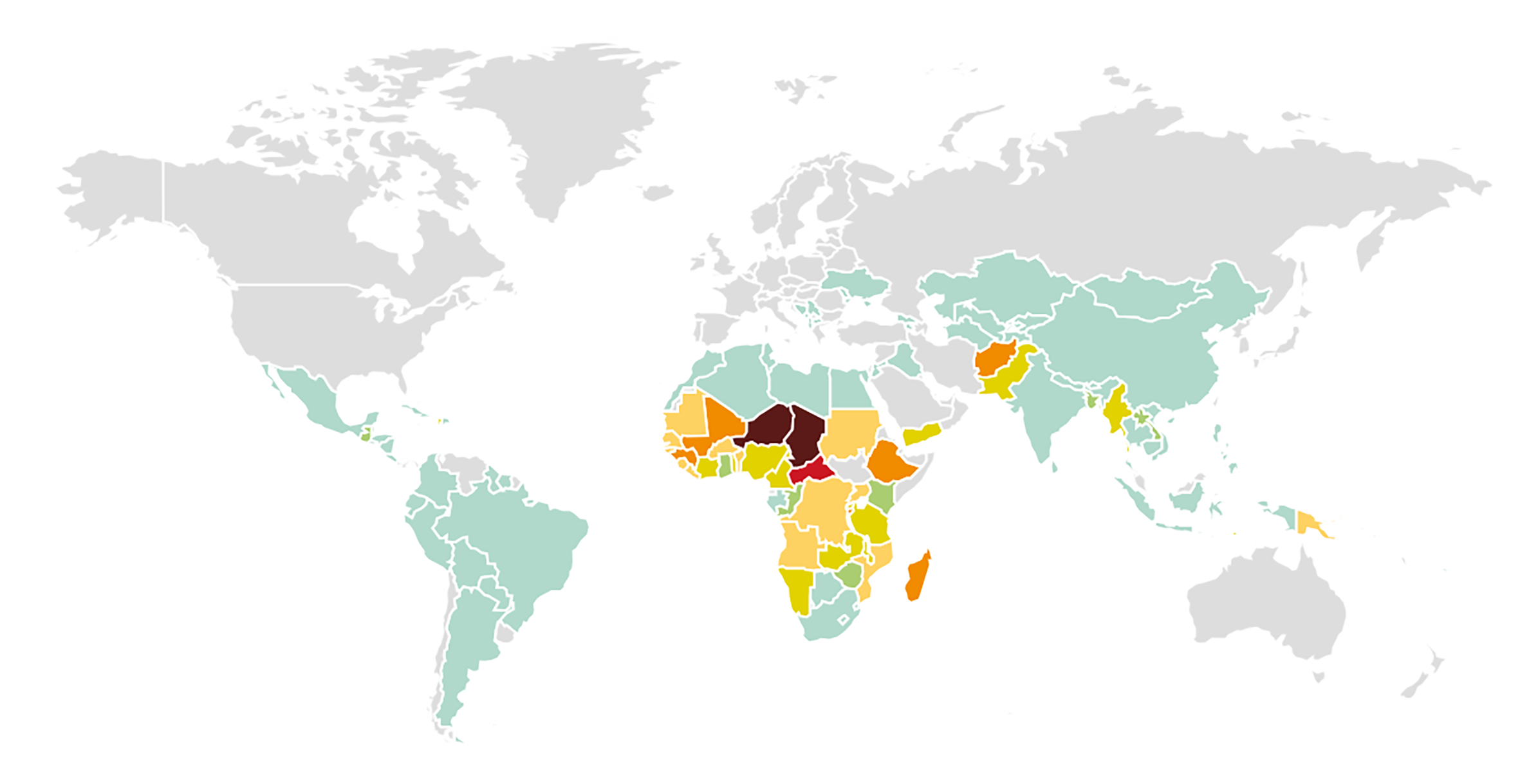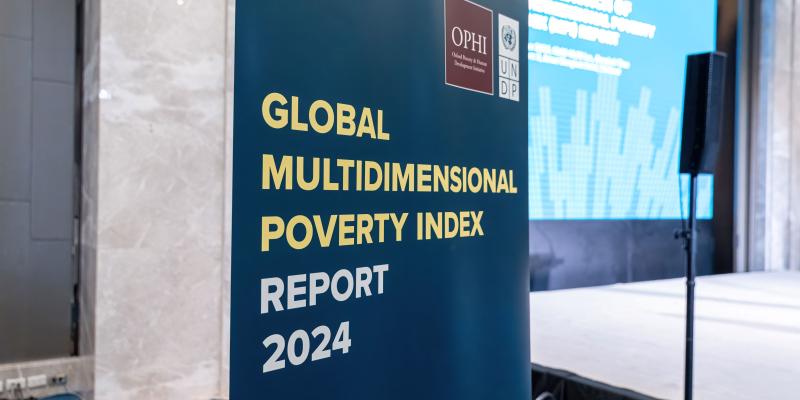Global MPI 2024
The 2024 global Multidimensional Poverty Index (MPI) uses the most recent comparable data available for 112 countries—21 low-income countries, 87 middle-income countries and 4 high-income countries. These countries are home to 6.3 billion people, about 92 percent of the population in developing regions, and of these 1.1 billion people are poor. Global MPI values, incidence and intensity of poverty, and component indicators are disaggregated for 1,359 subnational regions as well as by age group, rural-urban area and gender of the household head. In Table 6, we publish harmonised estimates for 86 countries, which provide results for trends over time. Forty have harmonized data for two points in time, 36 countries have trends data for three points in time, six have data for four points in time, three (Ghana, Mexico and Peru) have data for five points in time and Nepal has trends data for six points in time.
Our Joint Report
The 2024 global MPI report Poverty amid conflict is produced in partnership with OPHI and the Human Development Report Office of the United Nations Development Programme (UNDP). Our analysis takes what we know about poverty around the world today and overlays violent conflict data where some form of conflict or fragility existed in the year the household surveys were taken to better understand how poor people are affected by violent conflicts. The report examines some of the ways in which poverty and conflict intersect and reflects on what this means for poverty reduction. Overall, the findings clearly point to the urgent need for peace.
Citation: OPHI (Oxford Poverty and Human Development Initiative) and UNDP (United Nations Development Programme) (2024). Global Multidimensional Poverty Index 2024: Poverty amid conflict. United Nations Development Programme and Oxford Poverty and Human Development Initiative.
Our Data
The 2024 global MPI results are presented in eight Data Tables. Data Table 1 presents MPI country (national) results using the most recent DHS, MICS and national survey data from 112 countries, covering 6.3 billion people. The country (national) estimates are jointly produced by OPHI and UNDP’s Human Development Report Office (HDRO). Please refer to OPHI MPI Methodological Note 58 for the core methodology and country specifications.
In addition, the OPHI team produces an additional set of Data Tables (Tables 2–8). These include selected auxiliary statistics, including standard errors of key estimates. Data Table 2 presents estimations for multiple poverty cut-offs as a measure of robustness. The MPI and its partial indices are also disaggregated by several different population groups: age groups (Data Table 3), rural and urban areas (Data Table 4), subnational regions (Data Table 5) and gender of household head (Data Table 7). The disaggregated MPI results shared in these tables show the importance of going beyond national averages to identify important variations across population groups. Please refer to OPHI MPI Methodological Note 59 for OPHI’s disaggregation methodology and policies.
Data Table 6 presents trends over time in 86 countries using data from 2001 to 2023. Data Table 6 also contains disaggregated results of the extent to which poverty has changed over time for age groups, rural and urban areas, and for 863 subnational regions. Please refer to OPHI MPI Methodological Note 60 for trends over time methodology and country harmonisation details.
Finally, Data Table 8 presents all global MPI country (national) results published since 2010.
Our Country Briefings
The 2024 global MPI Country Briefings present the country-specific results for the countries in this year’s global MPI.
Documentation
The OPHI MPI Methodological Notes series is a technical paper series that provides details of the global MPI methodology and transparently documents the decisions made for each country dataset. An MPI Methodological Note is published for every global MPI release. MPI Methodological Notes are published with an accompanying set of data tables and, starting from 2018, Stata do-files.
Technical files
Our data preparation do-files allow you to generate the global MPI indicators from the microdata. This is the first technical step. Microdata are household surveys produced by specific survey providers such as DHS and MICS.
The technical files (or Stata do-files) for each country survey can be downloaded below. Please refer to OPHI’s Methodological Note series for information on survey details.
The do-files used for the purpose of generating the global MPI indicators are open access under the Oxford Academic licence.
Do-files as a zip package
The global MPI estimates are produced using the Stata package 'mpitb' by Nicolai Suppa. For more information visit this paper. This is the second technical step. The package produces estimations by national, by population subgroups, e.g. age groups, rural and urban areas, subnational regions and supports the estimation of levels and change between time periods. 'mpitb' simplifies estimations and analyses in cross-country settings.
The package is available at the Statistical Software Components (SSC) Archive and on gitlab. The MPI toolbox is distributed free of charge under an MIT license. The package may be installed by issuing 'ssc install mpitb' in Stata. To access its comprehensive help files, issue 'help mpitb' after the installation. 'mpitb' requires Stata 16 or higher.
Download the technical files (or Stata do-files) for each country survey
Our Interactive Databank

Browse through our databank to view the global MPI data in different ways and use it in briefings, teaching or presentations. This web application allows the user to explore the GMPI data through interactive graphics. Users can see the spatial spread of multidimensional poverty, its intensity and headcount. The application presents comparisons at global and country and subnational level.
Source: Global Multidimensional Poverty Index (MPI) Databank 2024 developed by Ayush Patel using data by Alkire, Kanagaratnam and Suppa (2024a and 2024b).
The Global Multidimensional Poverty Index (MPI) Databank is hosted on the Interactive Data Network (IDN), University of Oxford shinyapps.io account.
Events
News
OPHI and UNDP Press Release
- English: 1.1 billion people live in multidimensional poverty, nearly half a billion of these live in conflict settings
- Spanish: 1.100 millones de personas viven en situación de pobreza multidimensional; de ellas, casi 500 millones viven en escenarios de conflicto
- French: 1,1 milliard de personnes vivent en situation de pauvreté multidimensionnelle, parmi lesquelles près de 500 millions vivent dans des contextes de conflit
OPHI News
Media coverage highlights
- El País: La guerra no beneficia a nadie, y menos a los pobres
- AP: More than 1 billion people live in acute poverty. Half are children and many in conflict zones
- AFP: UN report says 1.1 billion people in acute poverty
- The Washington Post: More than 1 billion people live in acute poverty. Half are children and many in conflict zones
- Al Jazeera: UN report says 1.1 billion people living in acute poverty
- Le Monde: Plus d’un milliard de personnes dans le monde souffrent de pauvreté, selon l’ONU
- France 24: UN report says 1.1 billion people live in acute poverty worldwide
- Reliefweb: Global Multidimensional Poverty Index 2024 - Poverty and Conflict
- Deutsche Welle: Una de cada ocho personas del mundo vive bajo pobreza aguda
- University of Oxford: Research finds 1.1 billion people in multidimensional poverty, with nearly half a billion in conflict settings
- UN News: Nearly half the world’s 1.1 billion poor live in conflict settings
- Common Dreams: Violent Conflicts Trap World's Poorest as 1.1 Billion Face Acute Poverty
- Global Coalition to End Child Poverty: How are multidimensionally poor children affected by conflict?
- Channel Africa Radio: The 2024 Global Multidimensional Poverty Index report shows that 1.1 billion of people live in acute poverty
- Our World In Data: Beyond income: understanding poverty through the Multidimensional Poverty Index






